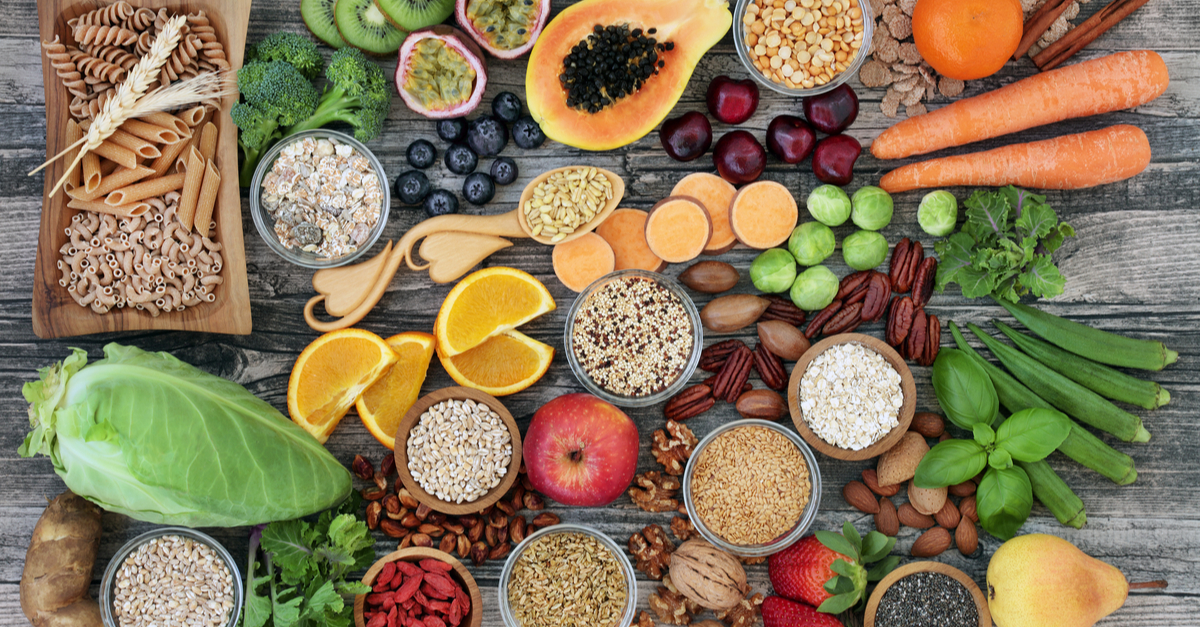The Many Forms and Functions of Fiber
Summary
Fiber is a large family of compounds composed mainly of carbohydrates that remain undigested through human metabolism. Dietary fiber is broadly classified into soluble or insoluble. Fiber is commonly known for its role in digestion, but it also has additional important functions in other parts of the body.
Fiber is commonly known for its role in digestion, but it also has additional important functions in other parts of the body. Current evidence points to numerous health benefits of consuming a high fiber diet, including reduction in atherosclerosis and other cardiovascular disease.1 While fiber is often categorized as either soluble or insoluble, there are other categorizations that suggest a more targeted therapeutic use of fiber through the diet or supplementation.
Forms of Fiber
Fiber is a large family of compounds composed mainly of carbohydrates that remain undigested through human metabolism. Dietary fiber is broadly classified into soluble (dissolving in water) or insoluble (not dissolving in water). In the past, certain types of fiber have been described as “functional,” and fiber may also be categorized by its viscosity or fermentability. The health benefits of fiber are often closely related to the specific fiber classification and array of physical properties.
Dietary fibers like beta-glucans, found in oats or psyllium, are soluble and form a gel during the digestion process. Soluble fibers have been shown to help with glucose and insulin response, along with reduction in low density lipoprotein (LDL) cholesterol.1 Insoluble fiber is coarse, does not form a gel, and is non-fermentable. This fiber type is beneficial for its laxative-type effects. Both soluble and insoluble fibers are readily available in fruits, vegetables, and whole grains.
Other dietary fiber types include:2
- Lignans
- Cellulose
- Hemicelluloses
- Pectins
- Gums
- Inulin
- Resistant starches
Resistant starches are insoluble fibers that act like soluble fibers. There are five different types of resistant starch, all with different properties depending on whether they are isolated or found in food form. With each type of resistant starch, there are nuances in how they behave functionally, such as heat responses and gelatinization.
Functional fiber has traditionally been defined as isolated non-digestible carbohydrates which have been extracted or synthesized from the original plant or animal form.2 Some of the current qualifying functional fibers according to the IOM are:2
- Psyllium
- Chitin and chitosan
- Fructooligosaccharides
- Galactooligosaccharides
- Polydextrose and polyols
Health Benefits of Fiber
Diets higher in dietary fiber have been associated with a variety of positive health outcomes. Epidemiological studies have demonstrated the reduced risk for cardiovascular disease, type 2 diabetes, and some cancers.3 This risk reduction has been determined to be linked to the function of fiber including satiety, reduced absorption of LDL cholesterol, and glucose.1,3 Dietary fiber sources like fruits and vegetables contain phytochemicals, which in animal studies have been shown to be correlated with lower inflammatory and oxidative stress markers.3
Dietary fiber has also been shown to alter gut microbiota form and function, which has modulatory effects on the immune system; different types of fiber have different effects on gut microbes.3 The production of short-chain fatty acids increases with the presence of dietary fiber, which has been hypothesized to inhibit cholesterol synthesis, thereby reducing serum cholesterol.3-5 The absorption of glucose is slowed in the presence of fiber which in turn may improve insulin sensitivity.3
Fiber intake has been correlated with the reduction of certain cancers including colorectal, liver, and breast.3 One hypothesis for the reduction in colorectal cancer risk is related to the increase in insoluble fibers which act to bulk up the stool aiding in the elimination of carcinogens.6 In the case of breast cancer, fiber is most likely aiding in the excretion of excess estrogen.7
Fiber Intake and Sources
Fiber is readily available in the diet in the form of fruits, vegetables, and whole grains. There are many supplemental forms of fiber, including concentrated whole foods as well as isolated fibers. Although fiber is easily obtainable in the diet, the US Dietary Guidelines for Americans estimates that more than 90 percent of females and 97 percent of males do not meet recommended intake for dietary fiber – constituting a public health concern. The intake recommendations vary by sex and age ranging from 25 to 34 grams daily for adults.
Plant based foods contain both soluble and insoluble fibers in varying amounts. Great sources of soluble fiber include bran flaxseed, oats, cereals, legumes, nuts, fruits, and vegetables. Whole grains such as wheat bran, brown rice, and barley are great sources of insoluble fiber. Vegetable sources of insoluble fiber include cabbage and celery. Generally, nuts, seeds, and whole grains have more concentrations of fiber than fruits and vegetables. Some higher fiber vegetables are squash, artichoke hearts, and spinach. Fruits that are higher in fiber include plums, guava, pears, and berries.
Some examples of the specific forms of fiber can be found in the following sources:
- Beta-glucans: oats, barley, mushrooms, and supplements
- Pectin: Fruit peels, extracts, and supplements
- Inulin and oligofructose: chicory root, sucrose, supplements, and food additives
- Guar gum: (derived from guar bean) used as a thickener, emulsifier, and in supplements
- Psyllium: (from the husk of psyllium seeds) found in cereal and supplements
- Chitosan: (from chitin) found in shellfish and supplements
Dietary fiber has been consistently associated with health promotion and disease prevention. Adult fiber intake in the Unites States is consistently low, creating public health concern. Developing strategies to optimize fiber intake is essential. Some ways to increase fiber intake daily include regular consumption of fresh fruits and vegetables, swapping less healthy snacks for nuts and seeds, consuming whole grains in place of more processed grains whenever possible, and utilizing food products fortified with fiber. Supplementation may also be part of an effective strategy for increasing fiber intake.
- Soliman, G. A. (2019). Dietary fiber, atherosclerosis, and cardiovascular disease. Nutrients, 11(5), E1155. https://doi.org/10.3390/nu11051155
- Institute of Medicine (U.S.), & Institute of Medicine (U.S.) (Eds.). (2005). Dietary reference intakes for energy, carbohydrate, fiber, fat, fatty acids, cholesterol, protein, and amino acids. National Academies Press.
- Veronese, N., Solmi, M., Caruso, M. G., Giannelli, G., Osella, A. R., Evangelou, E., Maggi, S., Fontana, L., Stubbs, B., & Tzoulaki, I. (2018). Dietary fiber and health outcomes: An umbrella review of systematic reviews and meta-analyses. The American Journal of Clinical Nutrition, 107(3), 436–444. https://doi.org/10.1093/ajcn/nqx082
- Anderson, J. W., Baird, P., Davis, R. H., Ferreri, S., Knudtson, M., Koraym, A., Waters, V., & Williams, C. L. (2009). Health benefits of dietary fiber. Nutrition Reviews, 67(4), 188–205. https://doi.org/10.1111/j.1753-4887.2009.00189.x
- Lattimer, J. M., & Haub, M. D. (2010). Effects of dietary fiber and its components on metabolic health. Nutrients, 2(12), 1266–1289. https://doi.org/10.3390/nu2121266
- Bultman, S. J. (2014). Molecular pathways: Gene-environment interactions regulating dietary fiber induction of proliferation and apoptosis via butyrate for cancer prevention. Clinical Cancer Research: An Official Journal of the American Association for Cancer Research, 20(4), 799–803. https://doi.org/10.1158/1078-0432.CCR-13-2483
- Rock, C. L., Flatt, S. W., Thomson, C. A., Stefanick, M. L., Newman, V. A., Jones, L. A., Natarajan, L., Ritenbaugh, C., Hollenbach, K. A., Pierce, J. P., & Chang, R. J. (2004). Effects of a high-fiber, low-fat diet intervention on serum concentrations of reproductive steroid hormones in women with a history of breast cancer. Journal of Clinical Oncology: Official Journal of the American Society of Clinical Oncology, 22(12), 2379–2387. https://doi.org/10.1200/JCO.2004.09.025







